Use of Ecofriendly Glass Powder Concrete in Construction of Wind Farms
Abstract
:1. Introduction
2. Materials and Methods
2.1. Materials
2.2. Characterization of Fresh Concrete
2.3. Sample Preparation
3. Results and Discussion
3.1. Characterization of Glass Powder
3.2. Results of the Characterization of Concrete
3.3. Mechanical Properties of Concrete
3.3.1. Mathematical Analysis of the Experimental Results
3.3.2. Simulation by Bolomey’s Formula
- Cs: Compressive strength of concrete (MPa);
- Csm: Compressive strength of a mortar of the same age (MPa);
- G: Granular coefficient;
- C: Amount of cement per m3 of concrete (kg/m3);
- k: additive coefficient; and
- V: volume of water per m3 of concrete (l/m3)
- V is the percentage of glass powder contained in the binder; and
- Cscem is the compressive strength of the concrete whose binder is only CEM I 52.5 R.
4. Conclusions
- -
- The addition of glass powder, as a substitute for cement with particles of dimension d50 = 16 µm, to the manufacture of the concrete, whatever its dosage, did not cause any improvement in terms of workability. In fact, the higher the glass powder replacement percentage, the worse the workability of the concrete;
- -
- The air content was higher with higher substitution of cement for glass powder. This fact increased the resistance of the concrete to the atmospheric phenomena of freeze–thaw cycles, without the need to include additives to achieve this effect;
- -
- Replacing cement with glass powder caused a higher air content. For this reason, the density of the different concretes varied, decreasing when the substitution of cement for glass powder increased; and
- -
- The consistency tests by means of a settlement test allowed us to classify these concretes within the group of fluid concretes, regardless of the dosage of glass powder used.
- -
- The use of glass in the binder increased the long-term compressive strengths of concrete;
- -
- The long-term compressive strengths of concretes containing glass powder were higher than Bolomey’s ones, whatever the amount of glass powder that the binder contained. Therefore, glass powder exerted an important activity in increasing the long-term compressive strength of concretes. At up to 50% replacement of CEM I 52.5 R cement by glass powder, the compressive strength values obtained were important enough to classify these concretes in the group of building concretes. At above 50% substitution of CEM I 52.5 R cement by glass powder, the resistance values obtained allowed these concretes to be classified in the group of concretes for paving roads and highways;
- -
- A mathematical model has been proposed to further analyze the experimental data. The model has proven to simulate quite well the results, as the errors were between 0.65% and 3.21% in relation to the calculated values of the final stable value of the compressive strength; and
- -
- Due to all the characteristic described, this concrete is proposed as ideal as a surface protection layer against the action of corrosion in wind turbine foundations as well as the stabilization of the wind farm roads. The proposed use of this final waster as a binder in ecofriendly concrete has a global impact on circular economy and may reduce the emission of greenhouse gases, because the destiny of this waste would be landfill.
Author Contributions
Funding
Institutional Review Board Statement
Informed Consent Statement
Data Availability Statement
Conflicts of Interest
References
- ONU Objetivos del Desarrollo Sostenible. Available online: https://www.un.org/sustainabledevelopment/es/ (accessed on 18 October 2020).
- ASCE. La Visión para la Ingeniería Civil en 2025; ASCE: Reston, VA, USA, 2006. [Google Scholar]
- Rodríguez, F.; Fernández, G. Ingeniería sostenible: Nuevos objetivos en los proyectos de construcción. Rev. Ing. Constr. 2010, 25, 147–160. [Google Scholar] [CrossRef] [Green Version]
- Fogarassy, C.; Finger, D. Theoretical and practical approaches of circular economy for business models and technological solutions. Resources 2020, 9, 76. [Google Scholar] [CrossRef]
- Fundación Conama; Council Green Building; RCD Asociación. Economía circular en el ámbito de la construccion. In Proceedings of the Congreso Nacional del Medio Ambiente 2018, Madrid, Spain, 26–29 November 2018; pp. 1–63. [Google Scholar]
- Švajlenka, J.; Kozlovská, M. Evaluation of the efficiency and sustainability of timber-based construction. J. Clean. Prod. 2020, 259. [Google Scholar] [CrossRef]
- Vidrio España. Contribución Económica, Ambiental y Social del Sector del Vidrio en España (2014/1016); Vidrio España: Madrid, Spain, 2017; p. 44. [Google Scholar]
- Marco, L.J.; García, E.; Más, M.I.; Alcaraz, V.; Luizaga, A. Estudio de la resistencia a compresión de morteros fabricados con conglomerante compuesto de polvo de vidrio. Inf. Constr. 2012, 64, 529–536. [Google Scholar] [CrossRef] [Green Version]
- Hogland, W. Remediation of an old landsfill site: Soil analysis, leachate quality and gas production. Environ. Sci. Pollut. Res. Int. 1994, 9, 49–54. [Google Scholar] [CrossRef] [PubMed]
- Slomski, V.G.; Lima, I.C.S.; Slomski, V.; Slavov, T. Pathways to urban sustainability: An investigation of the economic potential of untreated household solid waste (HSW) in the city of Saõ Paulo. Sustainability 2020, 12, 5249. [Google Scholar] [CrossRef]
- Rashidian-Dezfouli, H.; Afshinnia, K.; Rangaraju, P.R. Efficiency of Ground Glass Fiber as a cementitious material, in mitigation of alkali-silica reaction of glass aggregates in mortars and concrete. J. Build. Eng. 2018, 15, 171–180. [Google Scholar] [CrossRef]
- Serpa, D.; Santos Silva, A.; De Brito, J.; Pontes, J.; Soares, D. ASR of mortars containing glass. Constr. Build. Mater. 2013, 47, 489–495. [Google Scholar] [CrossRef]
- Aliabdo, A.A.; Abd Elmoaty, A.E.M.; Aboshama, A.Y. Utilization of waste glass powder in the production of cement and concrete. Constr. Build. Mater. 2016, 124, 866–877. [Google Scholar] [CrossRef]
- Thomas, C.; de Brito, J.; Corinaldesi, V. Special issue high-performance eco-efficient concrete. Appl. Sci. 2021, 11, 1163. [Google Scholar] [CrossRef]
- De Castro, S.; De Brito, J. Evaluation of the durability of concrete made with crushed glass aggregates. J. Clean. Prod. 2013, 41, 7–14. [Google Scholar] [CrossRef]
- Idir, R.; Cyr, M.; Tagnit-Hamou, A. Use of fine glass as ASR inhibitor in glass aggregate mortars. Constr. Build. Mater. 2010, 24, 1309–1312. [Google Scholar] [CrossRef]
- García Del Toro, E.M.; Más López, M.I. Study of new formations of C-S-H in manufactured with glass powder as binder mortar. Ing. Investig. 2018, 38, 24–32. [Google Scholar] [CrossRef]
- Liu, M. Incorporating ground glass in self-compacting concrete. Constr. Build. Mater. 2011, 25, 919–925. [Google Scholar] [CrossRef]
- Parghi, A.; Shahria Alam, M. Physical and mechanical properties of cementitious composites containing recycled glass powder (RGP) and styrene butadiene rubber (SBR). Constr. Build. Mater. 2016, 104, 34–43. [Google Scholar] [CrossRef]
- Nassar, R.U.D.; Soroushian, P. Strength and durability of recycled aggregate concrete containing milled glass as partial replacement for cement. Constr. Build. Mater. 2012, 29, 368–377. [Google Scholar] [CrossRef]
- Schwarz, N.; Cam, H.; Neithalath, N. Influence of a fine glass powder on the durability characteristics of concrete and its comparison to fly ash. Cem. Concr. Compos. 2008, 30, 486–496. [Google Scholar] [CrossRef]
- Shayan, A.; Xu, A. Performance of glass powder as a pozzolanic material in concrete: A field trial on concrete slabs. Cem. Concr. Res. 2007, 36, 457–468. [Google Scholar] [CrossRef]
- Shao, Y.; Lefort, T.; Moras, S.; Rodriguez, D. Studies on concrete containing ground waste glass. Cem. Concr. Res. 2000, 30, 91–100. [Google Scholar] [CrossRef]
- Guo, P.; Meng, W.; Nassif, H.; Gou, H.; Bao, Y. New perspectives on recycling waste glass in manufacturing concrete for sustainable civil infrastructure. Constr. Build. Mater. 2020, 257, 119579. [Google Scholar] [CrossRef]
- Fernández Cánovas, M. Hormigon: Adaptado a la Instruccion para la Recepcion de Cementos y a la Instruccion de Hormigon Estructural Ehe, 10th ed.; CICCP: Girona, Spain; Garceta: Madrid, Spain, 2013. [Google Scholar]
- Mas, M.I.; García, E.M.; Marco, L.J.; De Marco, J. Análisis de la Viabilidad Ambiental de la Utilización de Morteros Fabricados con Polvo de Vidrio en la Estabilización de Suelos. Inf. Tecnol. 2016, 27, 77–86. [Google Scholar] [CrossRef]
- ANEFHOP UNE-EN 12350-5:2020. Ensayos de Hormigón Fresco. Parte 5: Ensayo de la Mesa de Sacudidas; UNE: Madrid, Spain, 2020; pp. 1–15. [Google Scholar]
- Comité Técnico CEN/TC 104 Hormigón y Productos Relacionados UNE-EN 12350-7: Ensayos de Hormigón Fresco. Parte 7: Contenido de aire Métodos de Presión; UNE: Madrid, Spain, 2020.
- CTN 83—HORMIGÓN UNE-EN 1015-6:1999: Densidad Aparente del Hormigón Fresco 1999; UNE: Madrid, Spain, 1999.
- AENOR UNE-EN 12350-2. Ensayos de Hormigón Fresco. Parte 2: Ensayo de Asentamiento; UNE: Madrid, Spain, 2006; pp. 1–9. [Google Scholar]
- Hormigón, C. Técnico 83 UNE 83507 Rotura a Compresión; UNE: Madrid, Spain, 2004; p. 1. [Google Scholar]
- Más-López, M.I.; del Toro, E.M.G.; Patiño, A.L.; García, L.J.M. Eco-friendly pavements manufactured with glass waste: Physical and mechanical characterization and its applicability in soil stabilization. Materials 2020, 13, 3727. [Google Scholar] [CrossRef]
- Pereira-De-Oliveira, L.A.; Castro-Gomes, J.P.; Santos, P.M.S. The potential pozzolanic activity of glass and red-clay ceramic waste as cement mortars components. Constr. Build. Mater. 2012, 31, 197–203. [Google Scholar] [CrossRef]
- Taha, B.; Nounu, G. Properties of concrete contains mixed colour waste recycled glass as sand and cement replacement. Constr. Build. Mater. 2008, 22, 713–720. [Google Scholar] [CrossRef]
- Tan, K.H.; Du, H. Use of waste glass as sand in mortar: Part I—Fresh, mechanical and durability properties. Cem. Concr. Compos. 2013, 35, 109–117. [Google Scholar] [CrossRef]
- Mirzahosseini, M.; Riding, K.A. Influence of different particle sizes on reactivity of finely ground glass as supplementary cementitious material (SCM). Cem. Concr. Compos. 2015, 56, 95–105. [Google Scholar] [CrossRef]
- Fiol, F.; Thomas, C.; Muñoz, C.; Ortega-López, V.; Manso, J.M. The influence of recycled aggregates from precast elements on the mechanical properties of structural self-compacting concrete. Constr. Build. Mater. 2018, 182, 309–323. [Google Scholar] [CrossRef]
- Lu, J.-X.; Duan, Z.-H.; Poon, C.S. Combined use of waste glass powder and cullet in architectural mortar. Cem. Concr. Compos. 2017, 82, 34–44. [Google Scholar] [CrossRef]
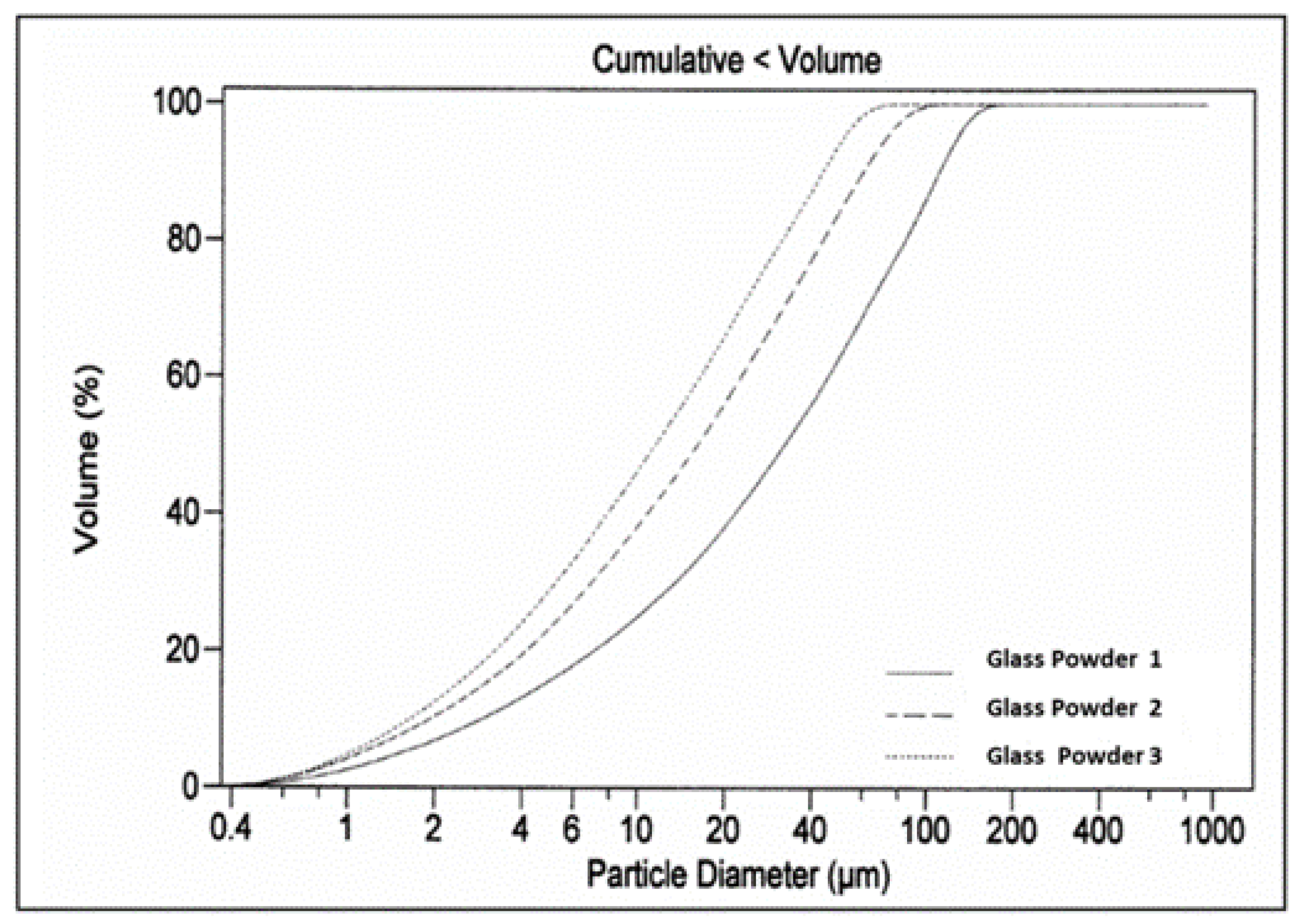

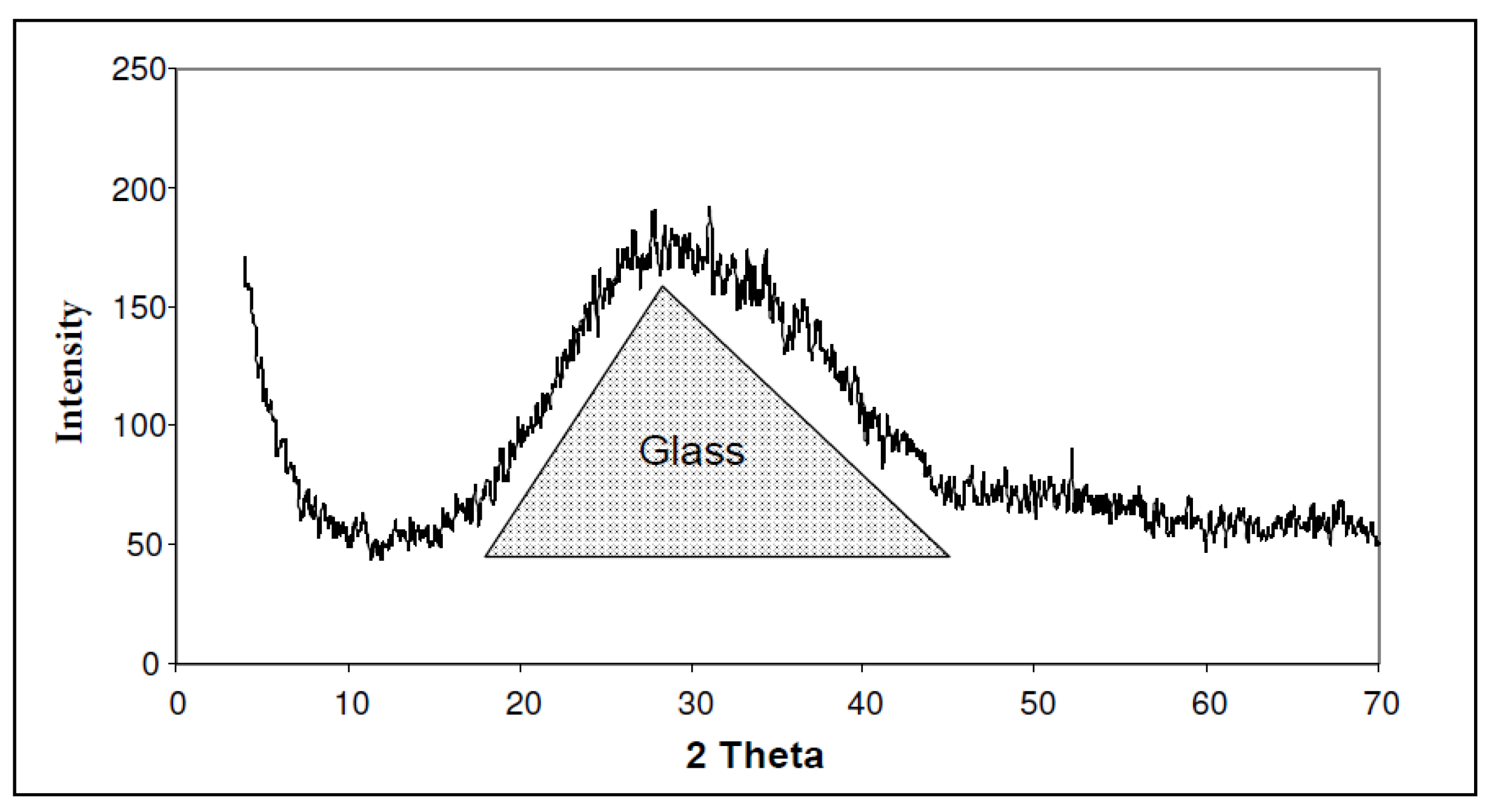
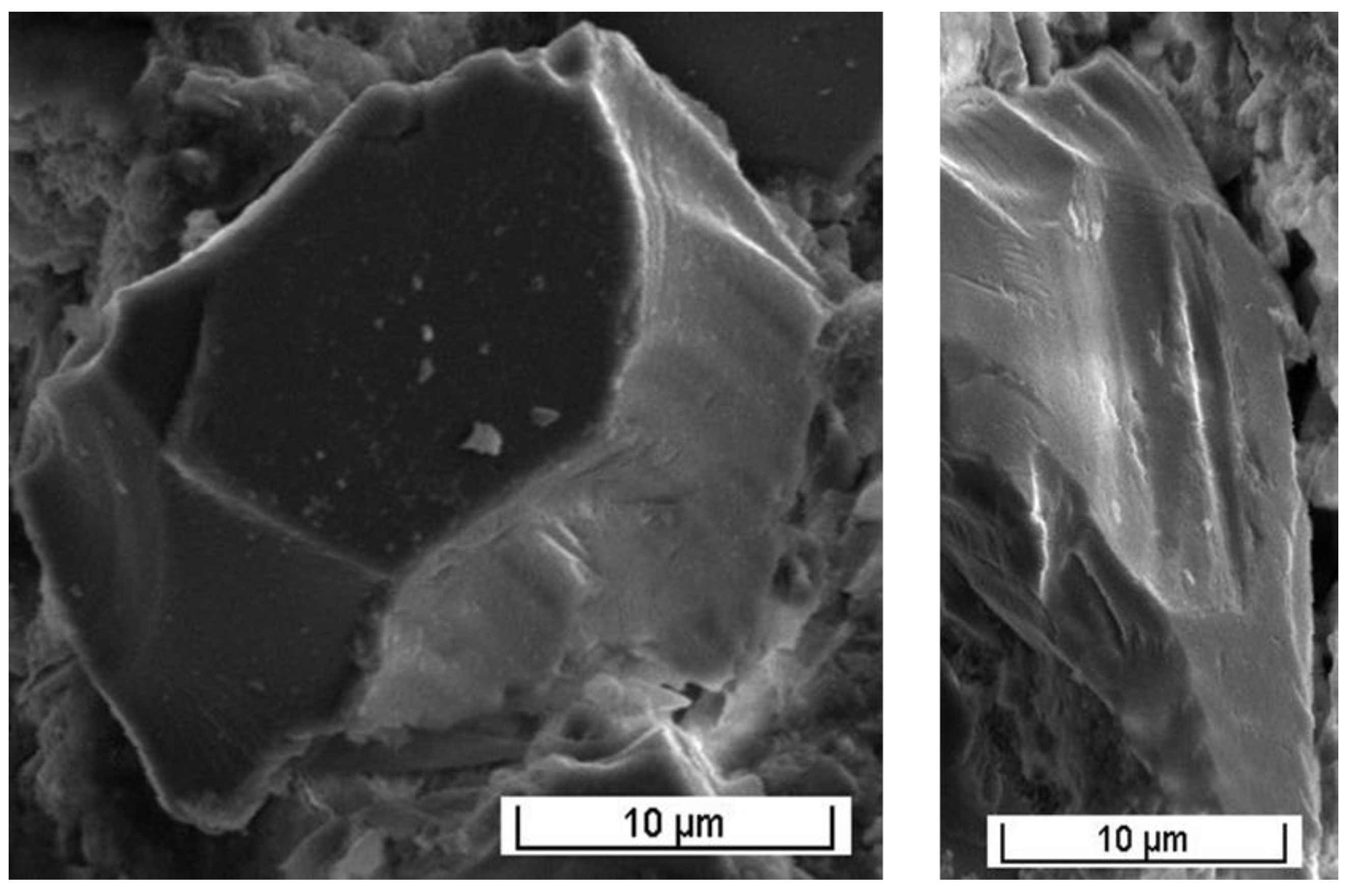

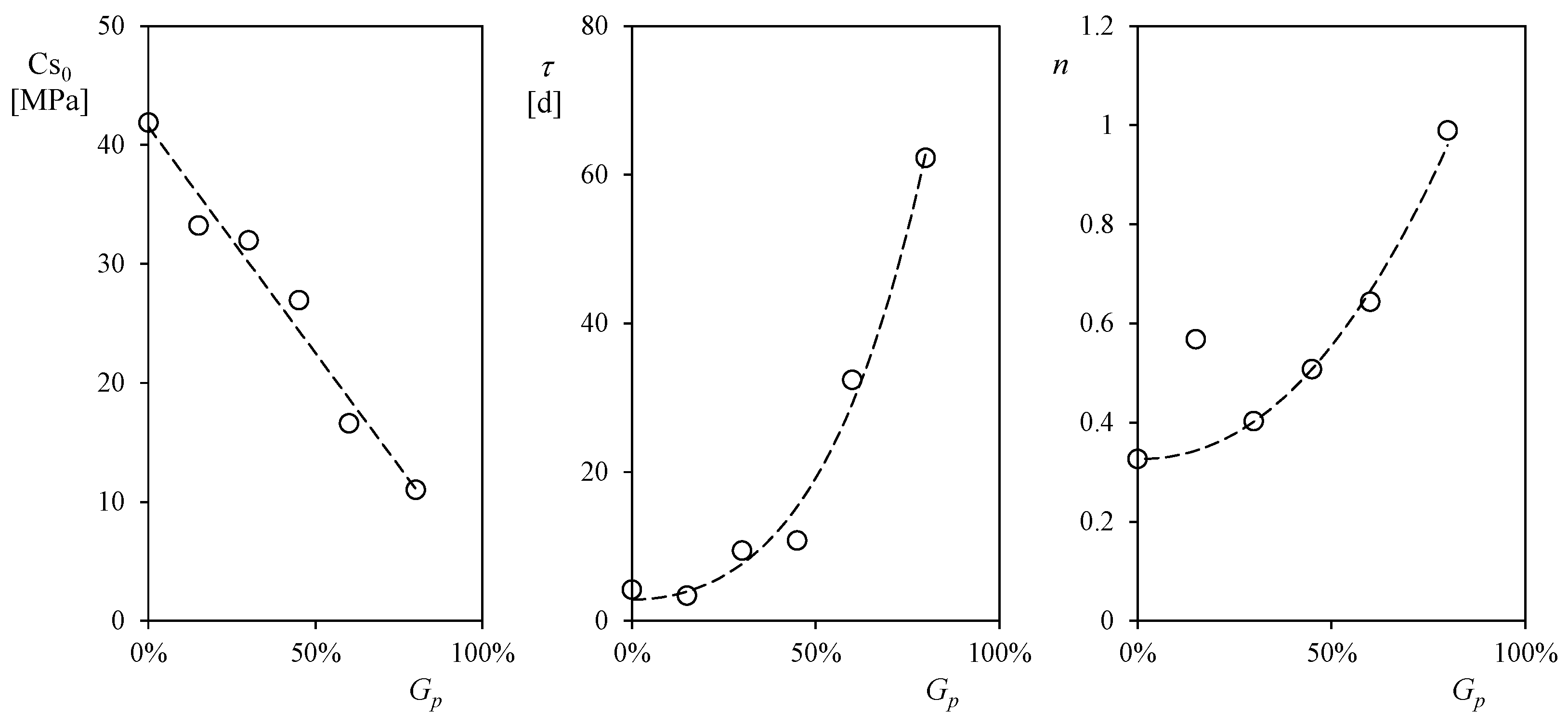

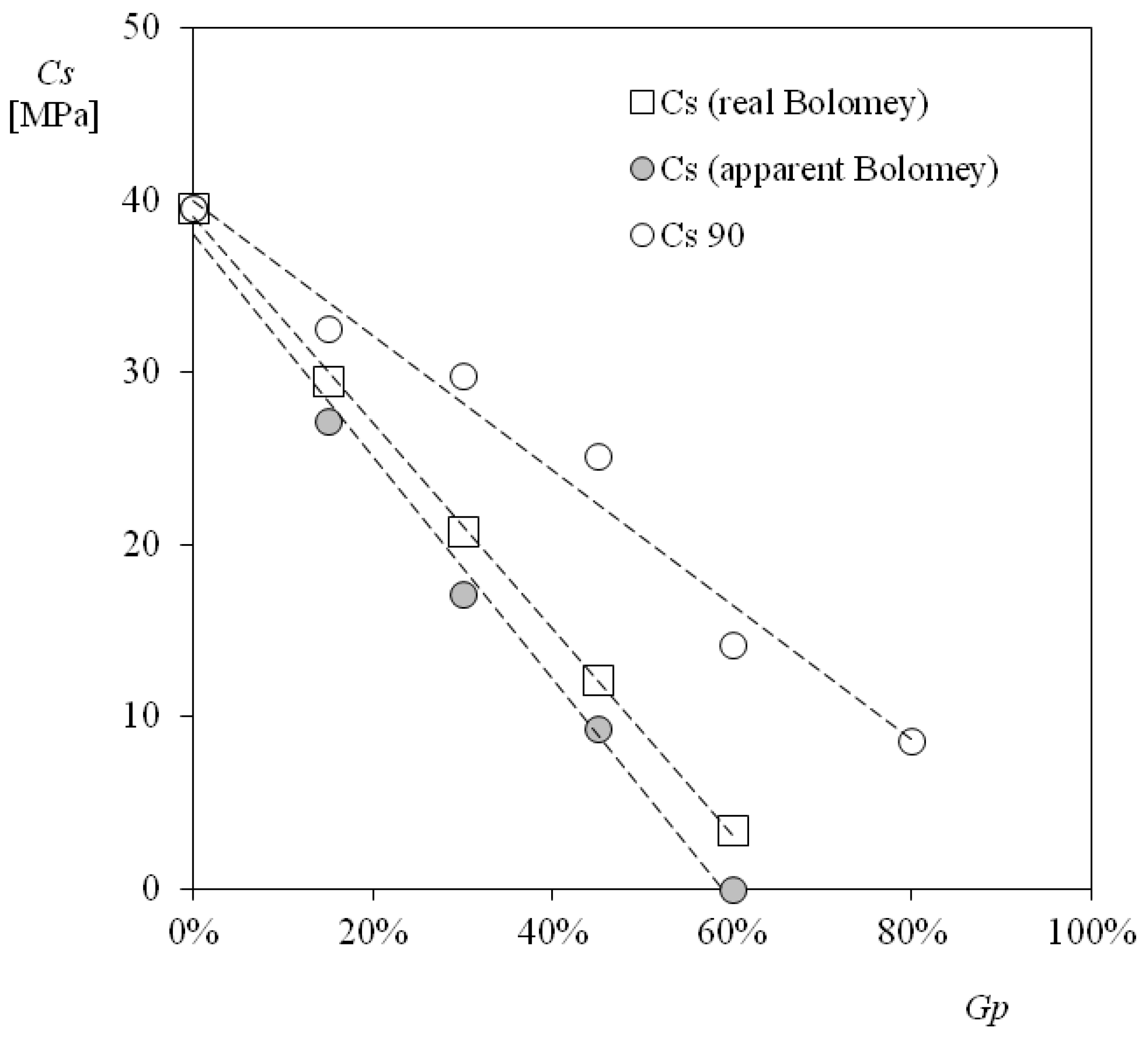
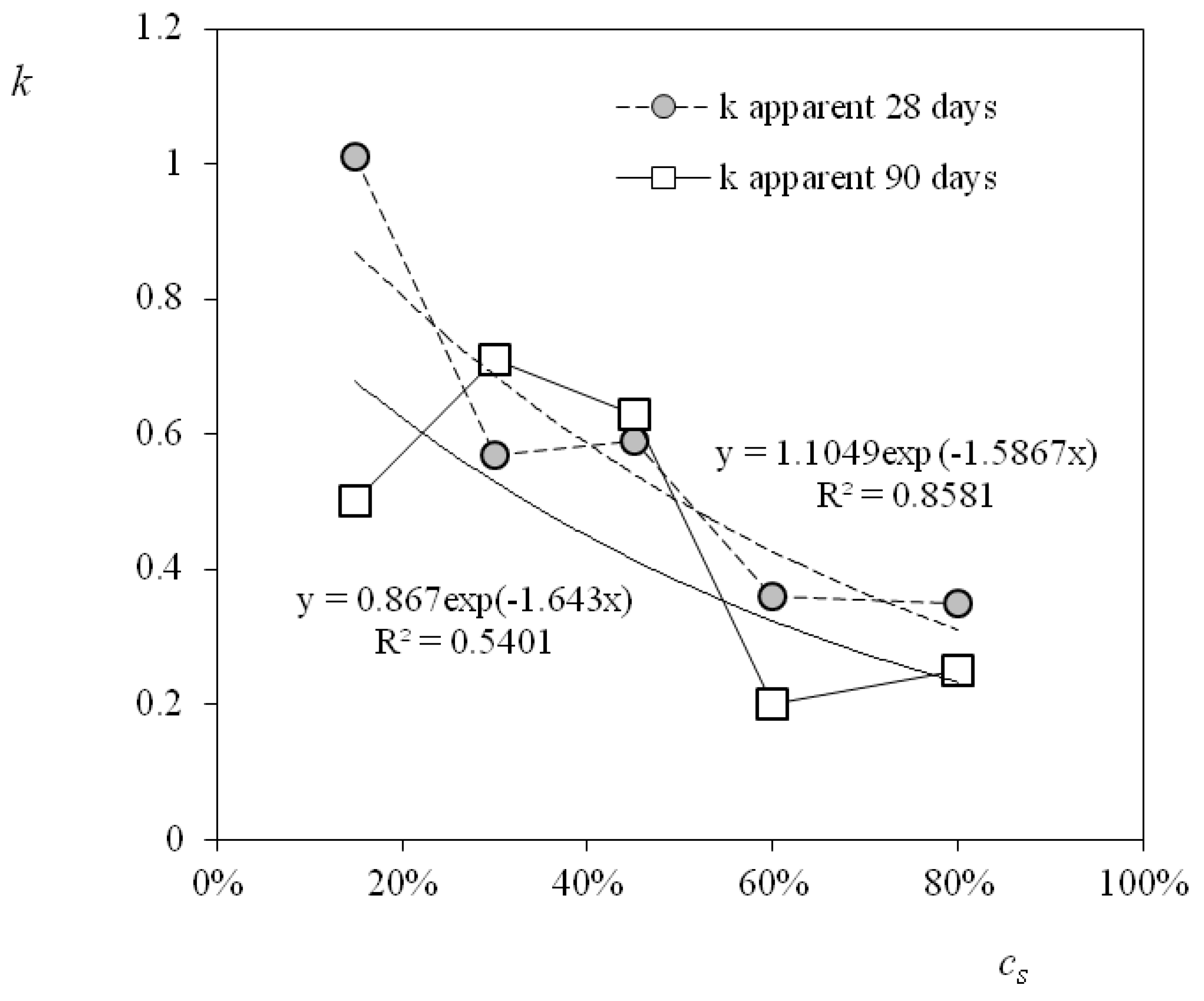


| Concrete Composition | Sample ID | |||||
|---|---|---|---|---|---|---|
| Control | G15 | G30 | G45 | G60 | G80 | |
| Cement substitution rate for glass powder (%) | 0 | 15 | 30 | 45 | 60 | 80 |
| Cement CEM I 52,5 R (kg/m3) | 330 | 280.5 | 231 | 181.5 | 132 | 66 |
| Glass Powder (kg/m3) | 0 | 49.5 | 99 | 148.5 | 198 | 264 |
| Equivalent binder (kg/m3) | 330 | |||||
| Plasticizer (% binder) | 0.35 | |||||
| Total water (L) | 184 | |||||
| Arid <4 mm | 740 | |||||
| Gravel 4–12 mm | 310 | |||||
| Gravel 12–20 mm | 850 | |||||
| Glass Powder Used | Griding Duration | d10 | d50 | d90 |
|---|---|---|---|---|
| T1 | 2 h 30 | 2.92 ± 0.01 µm | 33 ± 1 µm | 110 ± 3 µm |
| T2 | 4 h 15 | 1.96 ± 0.01 µm | 16 ± 1 µm | 59 ± 2 µm |
| T3 | 5 h | 1.65 ± 0.01 µm | 11 ± 1 µm | 43 ± 2 µm |
| Control | G15 | G30 | G45 | G60 | G80 | |
|---|---|---|---|---|---|---|
| Consistency (mm) | 11 | 16 | 16 | 16 | 14 | 13 |
| Air content (%) | 2.8 | 3.9 | 5.0 | 5.0 | 6.8 | 7.5 |
| Apparent density (kg/m3) | 2390.1 | 2351.0 | 2338.5 | 2330.5 | 2292.0 | 2282.0 |
| Workability (easy/difficult) | easy | easy | easy | medium | medium | difficult |
| t (Days) | Compressive Strength (MPa) | |||||
|---|---|---|---|---|---|---|
| Control | G15 | G30 | G45 | G60 | G80 | |
| 2 | 22.4 | 17.3 | 12.4 | 8.6 | 2.7 | 0.5 |
| 7 | 29.9 | 25.9 | 20.4 | 15.9 | 5.0 | 1.5 |
| 28 | 34.5 | 32.0 | 23.9 | 21.2 | 10.0 | 3.7 |
| 90 | 39.6 | 32.6 | 29.8 | 25.2 | 14.2 | 8.6 |
| 180 | 40.4 | 33.8 | 30.7 | 26.9 | 15.8 | 10.3 |
| Control | G15 | G30 | G45 | G60 | G80 | |
|---|---|---|---|---|---|---|
| Cs0 (MPa) | 41.89 | 33.237 | 31.978 | 26.964 | 16.618 | 11.011 |
| τ (d) | 1.5979 | 2.0105 | 2.4732 | 3.3509 | 9.3934 | 59.627 |
| n | 4.1999 | 3.4191 | 9.4455 | 10.810 | 32.400 | 62.276 |
| RMSE (MPa) | 0.608 | 0.364 | 1.025 | 0.634 | 0.107 | 0.226 |
| Bolomey Compressive Strengths (MPa) | Control | G15 | G30 | G45 | G60 | G80 |
|---|---|---|---|---|---|---|
| Cs 28 (Bolomey) apparent (k = 0) | 34.5 | 23.7 | 14.9 | 8.1 | 0 | / |
| Cs 28 (Bolomey) real (k = 0) | 34.5 | 25.7 | 18.1 | 10.6 | 3.0 | / |
| Coefficient considering the apparent k addition at 28 days | / | 1.01 | 0.57 | 0.59 | 0.36 | 0.35 |
| Coefficient considering the real k addition at 28 days | / | 0.67 | 0.30 | 0.42 | 0.20 | 0.24 |
| Compressive strengths and coefficients considering the addition | ||||||
| Cs 90 (Bolomey) apparent (k = 0) | 39.6 | 27.2 | 17.1 | 9.3 | 0 | / |
| Cs 90 (Bolomey) real (k = 0) | 39.6 | 29.5 | 20.8 | 12.2 | 3.4 | / |
| Coefficient considering the apparent k addition at 90 days | / | 0.5 | 0.71 | 0.63 | 0.20 | 0.25 |
| Coefficient considering the real k addition at 90 days | / | 0.20 | 0.42 | 0.45 | 0.15 | 0.34 |
Publisher’s Note: MDPI stays neutral with regard to jurisdictional claims in published maps and institutional affiliations. |
© 2021 by the authors. Licensee MDPI, Basel, Switzerland. This article is an open access article distributed under the terms and conditions of the Creative Commons Attribution (CC BY) license (http://creativecommons.org/licenses/by/4.0/).
Share and Cite
García del Toro, E.M.; Alcala-Gonzalez, D.; Más-López, M.I.; García-Salgado, S.; Pindado, S. Use of Ecofriendly Glass Powder Concrete in Construction of Wind Farms. Appl. Sci. 2021, 11, 3050. https://doi.org/10.3390/app11073050
García del Toro EM, Alcala-Gonzalez D, Más-López MI, García-Salgado S, Pindado S. Use of Ecofriendly Glass Powder Concrete in Construction of Wind Farms. Applied Sciences. 2021; 11(7):3050. https://doi.org/10.3390/app11073050
Chicago/Turabian StyleGarcía del Toro, Eva M., Daniel Alcala-Gonzalez, María Isabel Más-López, Sara García-Salgado, and Santiago Pindado. 2021. "Use of Ecofriendly Glass Powder Concrete in Construction of Wind Farms" Applied Sciences 11, no. 7: 3050. https://doi.org/10.3390/app11073050
APA StyleGarcía del Toro, E. M., Alcala-Gonzalez, D., Más-López, M. I., García-Salgado, S., & Pindado, S. (2021). Use of Ecofriendly Glass Powder Concrete in Construction of Wind Farms. Applied Sciences, 11(7), 3050. https://doi.org/10.3390/app11073050







